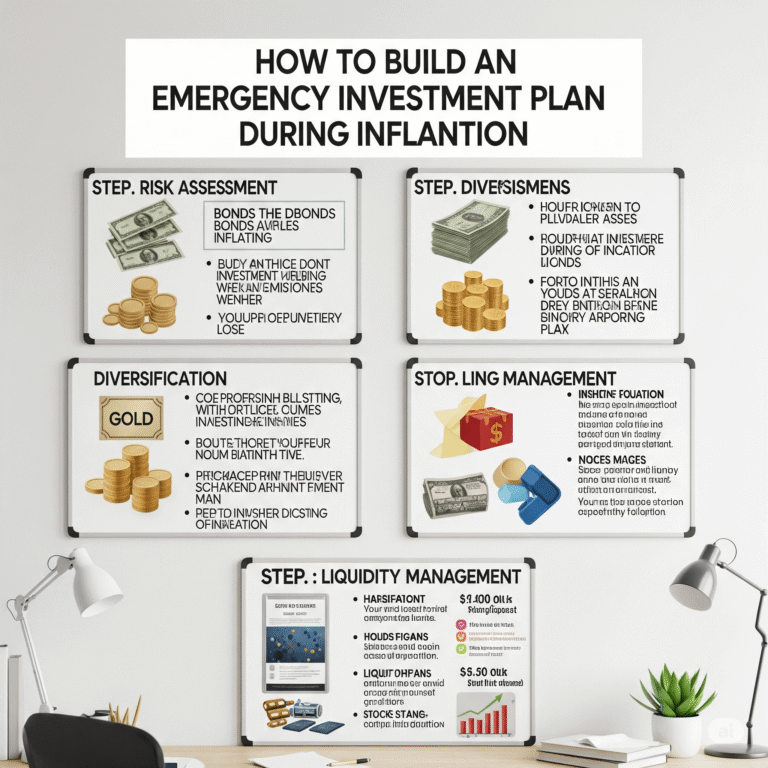Introduction
Inflation has become a financial reality that every UK investor must navigate. Prices are rising, interest rates fluctuate, and purchasing power is declining. During such uncertain times, one of the smartest things you can do is create an emergency investment plan, a strategic reserve that not only protects your assets but ensures financial flexibility.
This article explains how to build a solid emergency investment plan during inflation, based on Experience, Expertise, Authoritativeness, and Trustworthiness (E-E-A-T). We’ll break down asset choices, planning structures, and risk mitigation techniques relevant to today’s economic climate.
Why Inflation Demands Emergency Planning
Inflation erodes the value of cash and low-yield assets over time. A £10,000 savings account today may only have the buying power of £9,000 or less next year. Without a plan:
Your emergency funds lose value.
You may be forced to sell long-term assets at a loss.
Your future goals may become more expensive to achieve.
Thus, a well-structured emergency investment plan can act as a protective layer against inflation’s impact.
Key Components of an Emergency Investment Plan
Here are the core elements you should include in your emergency investment strategy:
1. Liquidity
You must be able to access funds quickly without penalties. This makes instant-access savings or short-term government bonds a solid foundation.
2. Capital Preservation
Protecting your principal is more important than high returns. Avoid high-risk investments like volatile tech stocks or crypto for this plan.
3. Inflation Protection
Use assets that grow in line with inflation or outperform it over time, such as index-linked bonds or dividend-paying stocks.
4. Diversification
Spreading assets across various sectors and instruments lowers the risk of sudden losses.
Table: Emergency Investment Options vs Inflation Risk
| Investment Type | Liquidity | Inflation Protection | Risk Level | Best Use Case |
|---|---|---|---|---|
| Cash (High-Interest A/C) | High | Low | Low | Short-term access (0–3 months) |
| Gold ETFs | Medium | Medium | Medium | Hedge against currency devaluation |
| Index-Linked Gilts (UK) | Medium | High | Low | Medium-term capital preservation |
| Dividend Stocks (Blue-Chip) | Low | High | Medium | Income and inflation buffer |
| Money Market Funds | High | Low | Low | Better return than cash |
Step 1: Determine Your Emergency Fund Size
A general rule is to save 3–6 months of living expenses. In times of inflation, consider stretching that to 6–12 months due to higher costs and delayed income recovery.
Example: If your monthly expenses are £2,000, aim for at least £12,000 to £24,000 in your emergency investment plan.
Step 2: Segment Your Fund
Break your fund into three parts:
Immediate Access (30%): Kept in high-interest savings or money market funds.
Medium-Term Access (50%): Invested in short-term bonds or gilts.
Long-Term Inflation Hedge (20%): Allocated to assets like gold, REITs, or dividend-paying stocks.
This structure ensures you’re protected against both short-term shocks and long-term erosion.
Step 3: Choose the Right Investment Vehicles
Choose regulated and secure platforms. In the UK, look for FCA-authorised brokers and banks.
Popular Platforms for UK Investors:
| Platform | Best For | Regulation |
|---|---|---|
| Hargreaves Lansdown | Gilts, ISAs, stocks | FCA regulated |
| Vanguard UK | Index-linked funds, bonds | FCA regulated |
| NS&I | Government savings products | UK government-backed |
| AJ Bell | SIPPs, diversified assets | FCA regulated |
Set up automatic contributions monthly. Rebalance your emergency portfolio every 6–12 months, especially if:
Inflation rates change significantly
Interest rates rise or fall
Your expenses increase
Tips for Protecting Wealth During Inflation
Avoid long-term fixed income bonds: These underperform in high inflation.
Review the budget quarterly to adjust for cost-of-living increases.
Use inflation-linked savings certificates if available (e.g., from NS&I).
Don’t lock all funds in ISAs or pensions; you need flexibility in emergencies.
Common Mistakes to Avoid
Relying entirely on cash: High inflation can erode savings quickly.
Investing emergency funds in high-risk assets: These are better suited for long-term growth portfolios.
Forgetting to review the plan annually: Inflation is dynamic. Your plan must be too.
Over-contributing to illiquid ISAs: Access can be delayed depending on the account type.
FAQ: Emergency Investment Planning During Inflation
Q1: Can I keep my emergency fund in stocks?
Only partially. It’s best to limit equity exposure to 10–20% for inflation hedging. Most of your funds should remain in liquid, low-risk assets.
Q2: How often should I review my plan?
At least once a year, or when your expenses or inflation rise significantly.
Q3: Is gold a good hedge against inflation?
Yes. Gold ETFs or sovereign gold bonds can hedge against currency devaluation and market volatility.
Q4: Should I use ISAs for emergency funds?
Use Cash ISAs with instant access. Avoid Stocks & Shares ISAs for emergency-only funds due to volatility and withdrawal timing.
Q5: What happens if I withdraw early from a bond or ISA?
You may face early exit fees, capital loss, or penalty interest reductions. Check terms before investing.
Final Thoughts
Inflation isn’t a temporary inconvenience; it’s a financial force that requires active planning and protection. A strong emergency investment plan isn’t just about storing money; it’s about preserving value, maintaining liquidity, and ensuring resilience during economic shocks.
UK investors can safeguard their future by understanding the real impact of inflation, choosing the right investment vehicles, and staying disciplined in their strategy.
Don’t wait until inflation eats into your wealth. Build a plan today—and stay ready for whatever tomorrow brings.


